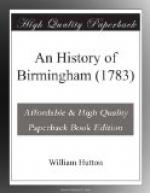An extract from that base act is as follows:—
“Whereas Edward Byrmingham, late of Byrmingham in the countie of Warwick, Esquire, otherwise callid Edward Byrmingham, Esquire, ys and standyth lawfully indettid to our soverene Lord the Kinge, in diverse grete summes of money; and also standyth at the mercy of his Highness, for that the same Edward ys at this present convected of felony: Our seide soverene Lord the Kinge ys contentid and pleasid, that for and in recompence and satisfaction to his Grace of the seyde summes of money, to accept and take of the seyde Edward the mannour and lordship of Byrmingham, otherwise callid Byrmincham, with the appurtinances, lying and being in the countie of Warwick, and all and singuler other lands and tenements, reversions, rents, services, and hereditaments of the same Edward Byrmingham, set, lying and beying in the countie of Warwick aforesaid. Be yt therefore ordeyned and enacted, by the authoritie of this present Parliament, that our seyde soverene Lord the Kinge shall have, hold, and enjoy, to him and his heires and assignes for ever, the seyde mannour and lordship of Byrmingham, &c.”
In the act there is a reservation of 40_l_. per annum, during the lives only of the said Edward and his wife.
It appears also, by an expression in the act, that Edward was brought to trial, and found guilty. Thus innocence is depressed for want of support; property is wrested for want of the protection of the law; and a vile minister, in a corrupt age, can carry an infamous point through a court of justice, the two Houses of Parliament, and complete his horrid design by the sanction of a tyrant.
The place where tradition tells us this diabolical transaction happened, is the middle of Sandy-lane, in the Sutton road; the upper part of which begins at the North east corner of Aston park wall; at the bottom, you bear to the left, for Sawford-bridge, or to the right, for Nachell’s-green; about two miles from the Moat, the place of Edward’s abode.
Except that branch which proceeded from this original stem, about 600 years ago, of which the Earl of Lowth is head, I know of no male descendant from this honourable stock; who, if we allow the founder to have come over with Cridda, the Saxon, in 582, must have commanded this little Sovereignty 955 years.
I met with a person sometime ago of the name of Birmingham, and was pleased with the hope of finding a member of that ancient and honorable house; but he proved so amasingly ignorant, he could not tell whether he was from the clouds, the sea, or the dunghill: instead of traceing the existence of his ancestors, even so high as his father, he was scarcely conscious of his own.
As this house did not much abound with daughters, I cannot at present recollect any families among us, except that of Bracebridge, who are descended from this illustrious origin, by a female line; and Sir John Talbot Dillon, who is descended from the ancient Earls of Lowth, as he is from the De Veres, the more ancient Earls of Oxford.




